Commercial Telegraph Keys
These telegraph keys were used for both commercial land line (wires) and wireless (radio) telegraphy. Commercial telegraphy began on May 24, 1844, the year of Morse's successful public demonstration of the Telegraph to the US Congress.
These "straight" or "hand" telegraph keys were used to send telegraph messages around the world, although, after about 1915, most telegraphers began using semi-automatic keys called "bugs." The keys shown on this page were used by railroad telegraphers, postal employees, stock brokers and others who needed high speed communications. You can click on any of these images to enlarge them.
These "straight" or "hand" telegraph keys were used to send telegraph messages around the world, although, after about 1915, most telegraphers began using semi-automatic keys called "bugs." The keys shown on this page were used by railroad telegraphers, postal employees, stock brokers and others who needed high speed communications. You can click on any of these images to enlarge them.
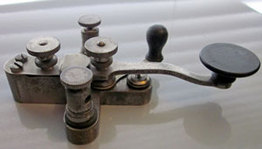
Steiner Key Manufactured by Western Electric:
This is a key designed and patented by Josef Steiner. It was manufactured between 1884 and 1890 by Western Electric Co. The Steiner key is a unique design with no fulcrum or trunions and it uses a flat spring in the rear as a fulcrum and return spring. This is the legless model with a triumph lever and shorting bar. [140]
This is a key designed and patented by Josef Steiner. It was manufactured between 1884 and 1890 by Western Electric Co. The Steiner key is a unique design with no fulcrum or trunions and it uses a flat spring in the rear as a fulcrum and return spring. This is the legless model with a triumph lever and shorting bar. [140]
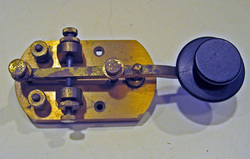
Signal Electric Manufacturing Company Model R-63 Standard Wireless Key:
This heavy duty brass key with a triumph lever is called the "Standard Wireless Key" since they were made for radio telegraphy. Signal Electric Mfg. Co. made many similar keys from the 1920s to the 1970s. They were originally designed for keying the high current primaries of early spark gap radio transmitters. The contacts are 1/4" diameter making this key a Model R-63. The key's base is embossed with the following text: SIGNAL ELECTRIC MFG, CO. MENOMINEE, MICH. [020]
This heavy duty brass key with a triumph lever is called the "Standard Wireless Key" since they were made for radio telegraphy. Signal Electric Mfg. Co. made many similar keys from the 1920s to the 1970s. They were originally designed for keying the high current primaries of early spark gap radio transmitters. The contacts are 1/4" diameter making this key a Model R-63. The key's base is embossed with the following text: SIGNAL ELECTRIC MFG, CO. MENOMINEE, MICH. [020]
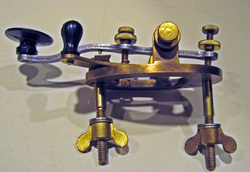
Signal Electric Manufacturing Company Model M101 Telegraph Key:
This is a triumph lever key that was also made by Signal Electric Mfg.Company. These were professional keys often used by railroads or newspapers that were permanently mounted on a table or desk. It has a brass body, a brass shorting bar and a steel triumph lever. The two "legs" that extend downward with the threads and wing nuts are for mounting the key on a table. The "legs" are also the electrical terminals. [037]
This is a triumph lever key that was also made by Signal Electric Mfg.Company. These were professional keys often used by railroads or newspapers that were permanently mounted on a table or desk. It has a brass body, a brass shorting bar and a steel triumph lever. The two "legs" that extend downward with the threads and wing nuts are for mounting the key on a table. The "legs" are also the electrical terminals. [037]
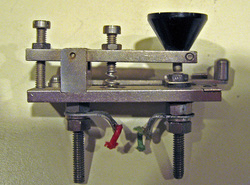
J.H. Bunnell & Company Model 6B Miniature Telegraph Key:
This Model 6B is one of the smallest actual operating straight keys. It was made by J. H. Bunnell Co. for Western Electric Company. It is about 2" long and it was used in telegraphy test gear in a group of four for meter bridge testing. It has a shorting bar and full tension adjustments. This particular key was built in the early 1960s and spent its working life in the Gila Bend, Arizona. Because of its small size, it is often advertised as a "spy" key! [033]
This Model 6B is one of the smallest actual operating straight keys. It was made by J. H. Bunnell Co. for Western Electric Company. It is about 2" long and it was used in telegraphy test gear in a group of four for meter bridge testing. It has a shorting bar and full tension adjustments. This particular key was built in the early 1960s and spent its working life in the Gila Bend, Arizona. Because of its small size, it is often advertised as a "spy" key! [033]
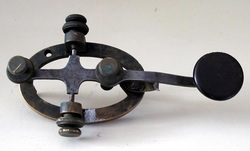
J.H. Bunnell & Company Leg Telegraph Key:
This is a steel triumph lever key made by J.H. Bunnell Co. Stamped on the base of this key are the words "Patented Feb.15, 1881" and "JH Bunnell and Company." A curved strip of metal, called a circuit closer, is just visible under the lever. I would date this key somewhere around 1910. The electrical contacts are attached to the keys "legs." [119]
This is a steel triumph lever key made by J.H. Bunnell Co. Stamped on the base of this key are the words "Patented Feb.15, 1881" and "JH Bunnell and Company." A curved strip of metal, called a circuit closer, is just visible under the lever. I would date this key somewhere around 1910. The electrical contacts are attached to the keys "legs." [119]
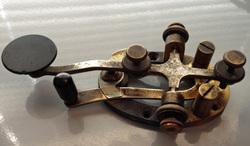
Western Electric Co. - AT&T Key:
This is a desk-mount brass key made by Western Electric for AT&T. It has a steel triumph lever with a black Bakelite knob and shorting bar. The words "Western Electric" are stamped into the shorting bar and the words "Telegraph Key" and "AT&T Co." are stamped on the rear of the base. The electric connections are on the top of the key. [138]
This is a desk-mount brass key made by Western Electric for AT&T. It has a steel triumph lever with a black Bakelite knob and shorting bar. The words "Western Electric" are stamped into the shorting bar and the words "Telegraph Key" and "AT&T Co." are stamped on the rear of the base. The electric connections are on the top of the key. [138]
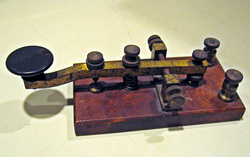
Wood and Brass Custom Made Railroad Telegraph Key:
This is a custom built, wood base, brass straight key that is approx 5" x 2” 3/4". The letters "GELB" are stamped or cut into the base. The lever has a brass mounting bracket and brass binding posts. It has an unconventional contact arrangement with the tension adjustment acting as electrical contact. It was probably custom built in a railroad shop. This key is very unusual and it is probably a pre-1900 key. Tom Perera, W1TP, dates it around 1881. [029]
This is a custom built, wood base, brass straight key that is approx 5" x 2” 3/4". The letters "GELB" are stamped or cut into the base. The lever has a brass mounting bracket and brass binding posts. It has an unconventional contact arrangement with the tension adjustment acting as electrical contact. It was probably custom built in a railroad shop. This key is very unusual and it is probably a pre-1900 key. Tom Perera, W1TP, dates it around 1881. [029]